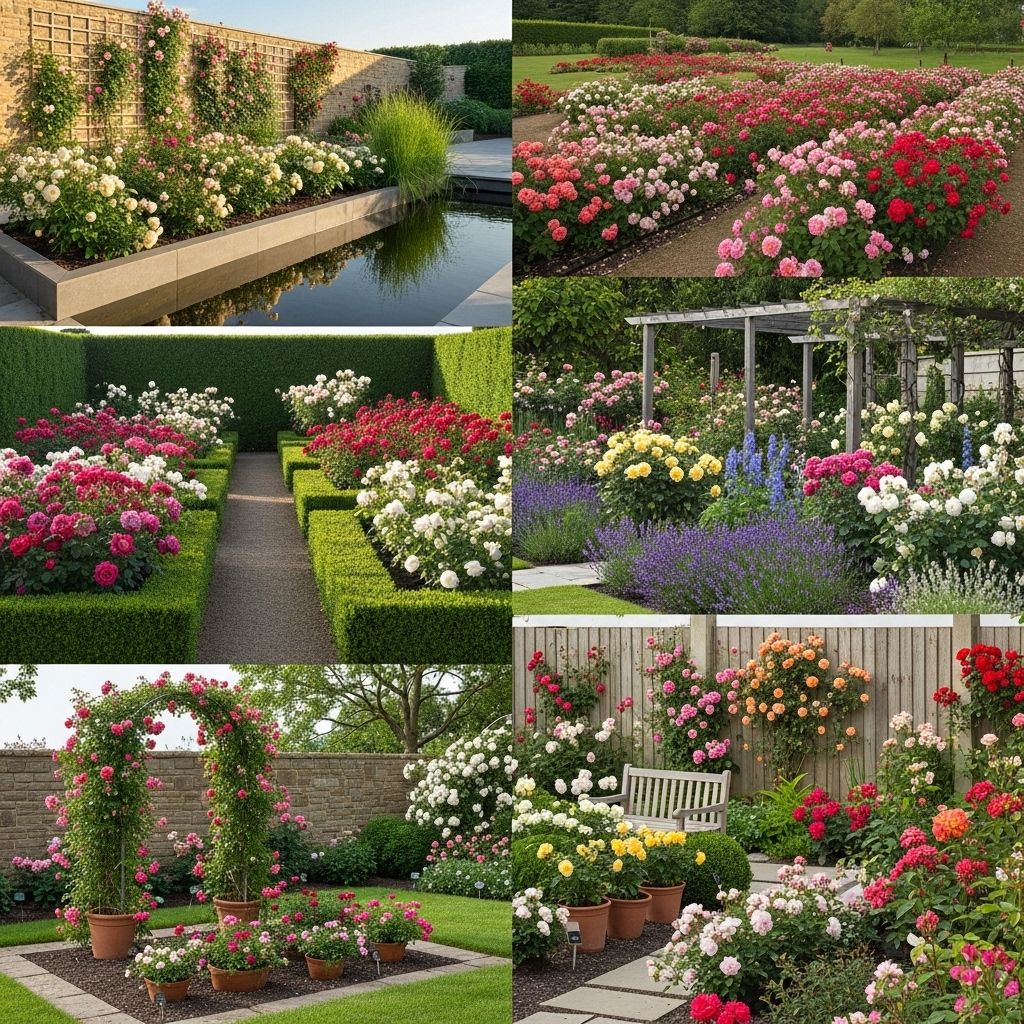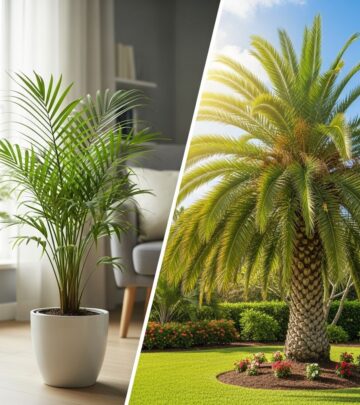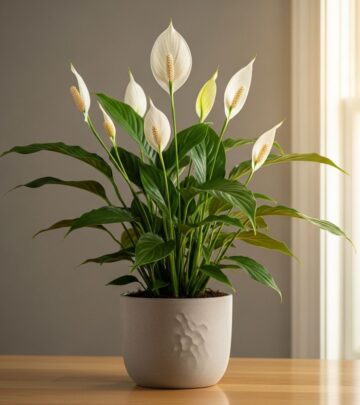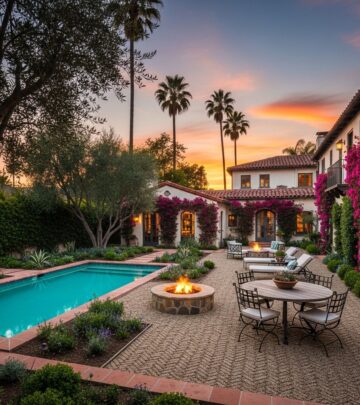10 Inspired Rose Garden Design Ideas for Every Outdoor Space
Enjoy fragrant blooms from sunken terraces to living canopies in any backyard setting.

Image: HearthJunction Design Team
For centuries, roses have symbolized romance, elegance, and natural beauty in gardens of every scale, from humble cottage plots to grand estates. With thousands of varieties—from climbing and rambling to heirloom, floribunda, and hybrid tea forms—the possibilities for designing with roses are nearly endless. If you’re dreaming about reviving a neglected border or planting your first dedicated rose bed, these 10 rose garden design ideas offer inspiration for every style, climate, and budget.
1. Sunken Rose Gardens
Sunken gardens are a classic choice for making roses the stars of the landscape. Positioning roses below ground level creates a sheltered microclimate, helping to protect delicate blooms from wind while providing a sense of intimacy and grandeur. Framed by retaining walls and tiled or gravel paths, a sunken design also offers natural places to sit and enjoy the fragrance up close. In larger spaces, formal symmetry and lavish plantings evoke the elegance of old European estates.
- Utilize terraced beds and stone walls for structure and drainage.
- Choose fragrant varieties at nose level for maximum enjoyment.
- Complement roses with low-growing groundcovers for textural contrast.
2. Rose Canopies and Living Tunnels
Create a magical outdoor room or passageway by training climbing and rambling roses overhead. A series of arches or a single sturdy pergola can support the lush growth of vigorous roses, offering a riot of blooms throughout the season and dappled shade on sunny days. These living canopies transform pathways and seating areas into unforgettable, scented retreats.
- Choose robust rambling roses, such as ‘Rambling Rector’ or David Austin’s English climbers, for wide coverage.
- Prune to encourage healthy arching stems and abundant flowering.
- Incorporate benches or garden swings beneath the canopy for relaxation.
3. Controlling Erosion: Ramblers on Slopes
On sloped or uneven terrain, rambling roses not only soften the landscape but help control erosion naturally. By sprawling and rooting along the ground, these vigorous varieties stabilize soil, making them an eco-friendly alternative to lawns or gravels on banks and hillsides.
- Plant at the crest or middle of slopes; allow canes to tumble naturally.
- Pair with tough, drought-tolerant perennials for a wild, meadow-like look.
- Low-maintenance and effective for slopes too steep to mow.
4. Roses as Living Hedges and Boundaries
Roses make outstanding living fences. Whether lining a walkway, marking property lines, or providing privacy, shrub roses and compact varieties can be clipped as hedges or left to ramble freely for a looser, more romantic effect. Hardy types like Rosa rugosa ensure year-round interest with hips and colorful foliage long after bloom.
- Create privacy or windbreaks with tall shrub roses planted closely together.
- Use compact shrub or groundcover roses as neat low borders.
- For a security barrier, consider the thornier cultivars.
5. Framing Entrances with Roses
There is no more inviting entryway than one framed by roses. Dress up front gates, doorways, or side-yard arbors with climbing or pillar roses to set a welcoming tone and add architecture to your landscape. This approach effortlessly elevates curb appeal and guides guests through your garden in style.
- Install a sturdy arbor or trellis as a support at entry points.
- Choose repeat-blooming climbers for an extended floral display.
- Mix in companion climbers like clematis for multi-layered interest.
6. Transition Spaces: Rose-Covered Arbors and Pergolas
Define and articulate outdoor ‘rooms’ by positioning rose-laden arches, pergolas, or tunnels at strategic intervals. These features can mark the transition between distinct zones, such as front and back gardens, or between more public and private areas. When the structure itself fades from view beneath swags of blooms, the effect is enchanting.
- Use archways to draw visitors deeper into the garden.
- Plant a mix of roses and flowering vines for continuous color.
- Ensure good air circulation and sunlight for healthy growth.
7. Roses as Dramatic Backdrops
Climbing roses trained along fences and walls make spectacular vertical displays and soften the harshness of wood or masonry. Utilize tall supports or attach canes with soft ties to guide growth and maximize coverage. This is an excellent way to dress up utilitarian fences or to provide privacy from neighbors.
- Favor vigorous climbers for quick coverage of unsightly walls.
- Alternate rose colors or combine with evergreen climbers for year-round interest.
- Maintain regular pruning to avoid woody, overgrown canes.
8. Foundation Plantings for All-Season Color
Line the front of your house or a beloved outbuilding with roses that bloom in succession for months of nonstop color. Mixing rose types with perennials or evergreen shrubs keeps the display going when one species is between flushes, and helps create a welcoming approach to your home. Layering heights brings both structure and softness to your foundation beds.
- Choose roses of varying bloom times for extended interest.
- Combine with low-maintenance perennials like catmint, lavender, or salvia.
- Allow at least 2 6 feet between bush roses for healthy air flow.
9. Monochromatic Plantings: Cohesive and Easy
One striking approach, especially for new or budget-conscious gardeners, is planting masses of a single color. Monochromatic schemes draw the eye, create drama, and visually expand garden beds. They also simplify plant buying and maintenance—key for those just starting out or working with limited resources.
- Choose one color family (all whites, all pinks, etc.) for your whole garden bed.
- Group 3 5 plants of the same variety together for higher impact.
- Adding texture through foliage creates depth without visual clutter.
10. Roses in Containers: Flexibility and Flair
Even if you’re short on space, you can enjoy roses in patios, balconies, or courtyards thanks to container gardening. Select compact or dwarf varieties suited for pots, such as patio roses or miniature climbers. Elevating roses in containers brings flowers closer to your living space—and makes seasonal changes easy.
- Choose well-draining, large pots for root health.
- Use high-quality potting mix enriched with compost.
- Rotate containers for even sunlight; water consistently.
Essential Tips for a Successful Rose Garden
- Sunlight: Roses require at least 6 hours of full sun daily for best blooms.
- Soil: Well-drained, fertile soil is key. Amend with compost and ensure adequate aeration.
- Pruning: Regular pruning improves airflow and encourages new growth and flowering.
- Watering: Deep watering once or twice weekly is preferable to frequent, shallow watering.
- Disease resistance: Select modern, disease-resistant cultivars for easier maintenance.
Choosing the Right Rose for the Right Spot
| Type | Best Use | Notes |
|---|---|---|
| Climbing/Rambling Roses | Arbors, walls, canopies, fences | Require sturdy supports and annual pruning |
| Shrub Roses | Hedges, borders, foundation plantings | Hardy, many repeat-blooming varieties |
| Floribunda & Hybrid Tea | Formal beds, containers, mass plantings | Dense blooms, classic shapes |
| Miniature/Patio Roses | Containers, small gardens, table centerpieces | Compact, prolific flowering |
FAQ: Frequently Asked Questions About Rose Garden Design
Q: Can I grow healthy roses in partial shade?
A: While most roses need full sun, some varieties like ‘Zephirine Drouhin’ and ‘Eden’ tolerate partial shade if they receive at least 4 6 hours of sunlight daily.
Q: How do I prevent common rose diseases?
A: Select disease-resistant cultivars, plant with sufficient spacing for air circulation, water at the base (not overhead), and remove diseased leaves promptly.
Q: What are the best companion plants for roses?
A: Good companions include lavender, catmint, and salvia, which deter pests and offer color and texture contrast.
Q: Can roses be grown organically?
A: Yes. With proper variety selection, compost-rich soil, and attention to cultural practices, roses can thrive without synthetic chemicals.
Q: How do I start a rose garden on a budget?
A: Focus on local or bulk rose sales, limit your color palette, and use mulch or inexpensive groundcovers to stretch your plantings while keeping maintenance low.
Conclusion: Design a Garden as Unique as Your Roses
There’s a reason roses have remained beloved across generations. With thoughtful garden design strategies, you can showcase their timeless beauty in ways that fit your personal style and available space, whether it’s a sprawling estate or a sunny balcony. By experimenting with these 10 inspired ideas—sunken terraces, living canopies, slope stabilizers, hedges, entries, transitions, dramatic backdrops, foundation gardens, monochrome plantings, and mobile containers—you’ll create an outdoor retreat that’s fragrant, colorful, and full of lasting joy.
References
- https://www.gardendesign.com/roses/
- https://www.gardenista.com/posts/landscaping-10-rose-garden-design-ideas/
- https://www.gardenia.net/guide/how-to-create-the-perfect-rose-garden
- https://www.gardenista.com/posts/landscape-on-a-budget-the-250-dollar-rose-garden/
- https://www.gardenista.com/posts/gardening-101-roses-rosa-plant-guide/
Read full bio of Shinta












